The big difference between this game and the play of the previous version of the scenario is that this is the moment that Squad Leader adds tanks to the mix – or Armoured Fighting Vehicles (AFVs) to use its terminology. The rules for AFVs are not particularly difficult, especially in comparison to how complicated they would become throughout the development of the Squad Leader line and eventually into Advanced Squad Leader, but they do take up a significant amount of space in the rulebook. However, I’d have a couple of turns of grace before I had to really worry about the tank rules, as only infantry began on the board to begin with.
Setting up the scenario poses its own challenges, especially on the left-hand side of the map away from the Tractor Works. The Germans there had done a particularly bad job of defending themselves against the Russian Guards in my last play-through, so I attempted to set them up a little more spread and away from the big presence of the Russian elite troops. Meanwhile, the Russians in the factory put only the weakest of their units on the right-hand side near the German engineers, and put a big “kill-stack” of troops in the middle of the factory, there to help repel invaders. Would it work?
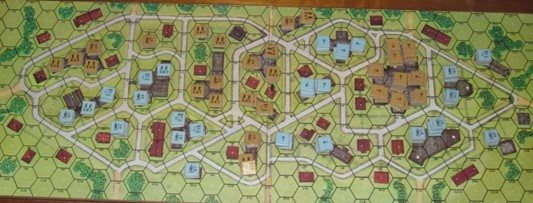
Possibly the biggest challenge facing the Germans in this scenario are the Russian troops in the central buildings; there are truly a lot of them! The Germans don’t really have the firepower to take them on, so they need to rely on concealment and breaking it as the Russians cross the street. There’s just one problem here: the Russians have enough massed firepower so even with it halved for Area Fire (firing into concealed hexes – the idea being they’re shooting at anything in the hex rather than directly targeting troops they can see), there’s a fair chance they’ll be effective enough to remove the concealment and start breaking the Germans.
The die-roll for the initiative went to the Germans, and those small stacks of units they had fired; mostly to no effect. Meanwhile, the German engineers and their flamethrowers cut loose, burning a hole in the Russian defenders of the factory. One of the concealed squads to the left of the factory made a run at the factory, hoping to remove some concealment. It was moderately successful: one of the German troops fired extremely inaccurately, their machine-gun breaking in the attack, but a second stack revealed itself and eliminated the lone German squad before it could cause any more trouble. One of the Russian Guards went berserk, and another suffered from elimination – Fate was having a hand in the initial stages of the battle! An entire stack of three Russian squads was broken in the Defensive Fire Phase (centre-bottom of the map), and for a short time, the Germans had hope that their fates wouldn’t be the same as the last time.
Then came the Russian onslaught: the hordes of their Guards rushing to take out the first building of German defenders, the berserk unit in the lead. It was not a pretty sight to see the wreckage of the German line afterward; the “rear” opening position had not been successful, and the Russian Guards were equally effective in the Advancing Fire Phase at point blank range.
One of the more noticeable differences with Advanced Squad Leader is how much safer units are when moving. Not in the open, mind you: movement in Open Ground gives the same -2 penalty as in ASL with FFMO and FFNAM applying. However, the concept of Assault Movement (moving only one hex) and not taking a penalty to defences doesn’t exist in this early stage of the system. As a result, even using the reactive fire system which allows fire in the Move Phase, units in buildings are rarely worth firing at until the Defensive Fire Phase.

The Germans had only their second turn before the tanks arrived, and they stormed the German positions in the Tractor Works as well as they could. Otherwise, it wasn’t looking too pretty: too few German troops, too many Russians! The German defenders on the left and middle of the map were slowly being overwhelmed.
As I learnt ASL first (mainly through a combination of the ASL Starter Kits and the ASL 1st edition rulebook), there are a few ASLisms that I assume that are part of Squad Leader which aren’t actually part of the system yet. As I was browsing through one of the Q&A files, handily compiled by the Squad Leader fans of the internet, I discovered that Squad Leader actually doesn’t keep track of which individual units possess each support weapon (Demolition Charges, Machine Guns, Flamethrowers, etc.) If they’re in the same hex, any unit can use or carry them, although SL does make sure that they can’t be used twice! ASL stacks the weapons on top of the counter that actually is holding them. Once I realised that, I happily began to put the MGs underneath other units on the map, giving me (and you) a clearer idea of where actual forces were – broken or in good order.
And then the tanks rumbled in: four Russian tanks, demonstrating that they could hit the buildings the remaining Germans were clustered in, but couldn’t actually roll well for their effect!
The German defenders on the left were really crumbling now, with several key buildings lost to the Russians. However, the line that had entered the factory were doing much better, even with berserk Russians engaging them in melee!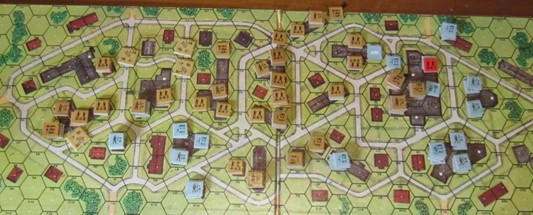
Tanks are funny things: infantry require either special weapons to affect them, or to be adjacent to them and pass some rather difficult checks to immobilise or break them in melee. (The Russian Guard and German Engineers would have much better chances of getting rid of enemy tanks if they could). I spent a fair amount of times perusing the rules to determine the effects of machine-gun fire on tanks, something that the rules never bring out explicitly; it’s there by implication, but that’s it. This may, in fact, be due to the fact that under the basic Squad Leader rules, machine-guns (medium and heavy) have such pathetic “To Kill” numbers (in the negatives!) that they can’t actually kill any AFV in the basic game! Or it might be that I’m misinterpreting something, which is entirely possible. Critical Hits for tanks would come in one of the gamettes, but they’re not there yet.
Of course, Tanks are scary to infantry in the open, but not so scary if the infantry have a nice stone building to cower in, and that’s basically what the Germans did. Oh, some did try to run at the tanks, but they soon realised that this wasn’t the best idea.
The good news for the Germans was their tanks were now entering the battlefield. I sped them around the Tractor Works to make things very difficult for the Russians in the factory and for the Russians trying to make their way to the factory. The Russians really should have been using Sewer Movement now, but their leaders were back, trying to rally their broken troops, and so weren’t available to lead their troops through the sewers.
On the other hand, the German defenders on the left-hand side of the map were now quite surrounded and in the last moments of their battle! The Russians began to flood towards the Tractor Works.
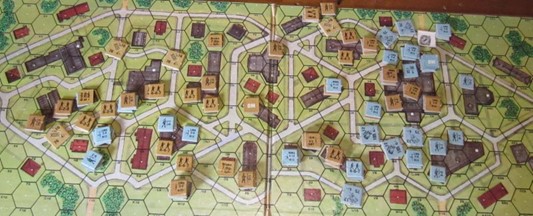
Tanks began to fight tanks. Experienced Squad Leader players probably have a lot better tactics for their tanks than my own, which generally involve sitting the tanks facing each other and taking pot-shots. Mobility? What’s that (to be fair, the Streets of Stalingrad are pretty cramped and presenting one’s rear to the opponent seems a bad idea). The Russian tanks came out the worse for it in the initial salvoes, with two of their tanks – half their force – being eliminated. The fight in the Factory was going really well for the Germans, and the Germans were able to hold off the reinforcing Russians, but to the left, the remaining German troops were now locked in melee with little chance of surviving another turn. The Russians now pretty much had half of their victory conditions; they only needed to prevent the Germans from taking and holding six hexes of the Tractor Works to win. Would they be able to do it?
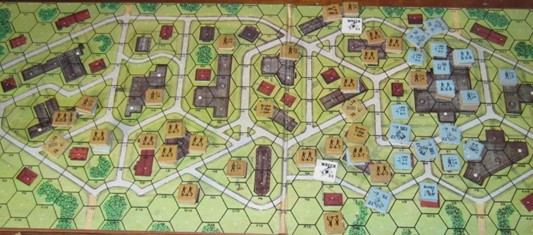
One of the features of Squad Leader (and its bigger descendant, and wargames in general) is that scenarios tend to play quicker as you go through them. They manage this by the simple method of having fewer pieces on the board as the game continues – as the squads die, the weapons break, and the tanks blow up! So, while the first few turns had taken a long time, I was able to move through the final turns a lot more rapidly.
The Russians managed to immobilise one of the German tanks, leaving it pointing at the Russian infantry as they massed to try and retake the factory (not actually the best position for it to be). Other attempts at blowing up tanks proved unsuccessful, and the presence of the German tanks made a decided roadblock in the way of the Russian troops streaming towards the factory.
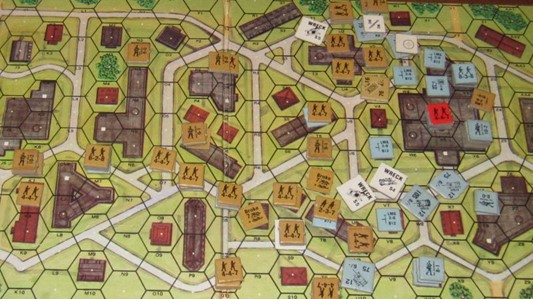
Finally, the Russians were able to destroy the two German tanks at the top of the map, opening a way for their troops to get through, even as the German defenders moved towards the left side of the factory to make it even more difficult for the Russian reinforcements to get through. Machine-gun fire from the Tanks and some accurate main gun firing was proving very effective in stopping the Russian troops!

The Russians made one more attempt to get through, but they needed their leaders: their infantry was too far back! The northern set of soldiers were able to run around the top of the factory and advance into its top-right hexes, but the German tanks held back the remainder. It was time to do a count of the control of Tractor Works hexes!
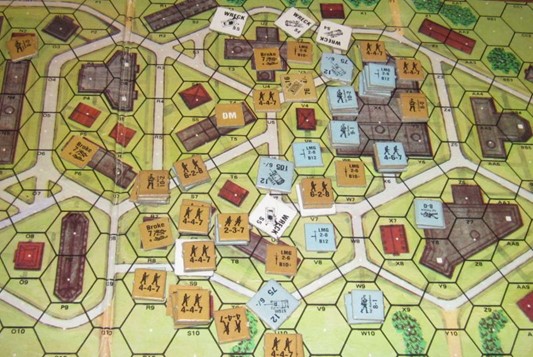
The final result – the Germans held six of the hexes, just enough to force the draw! Once again, the Russian Guards had overwhelmed the Germans on the left-hand side of the board, but they were unable to come to the aid of their fellows in the Tractor Works. An epic scenario had ended with neither side the winner. Sort of disappointing, really!
With this over, I’ll be moving onto the first of the countryside scenarios in Squad Leader; scenario 4, which offers a particularly tricky set-up for solitaire players: Hidden Placement. We’ll see how that goes…
